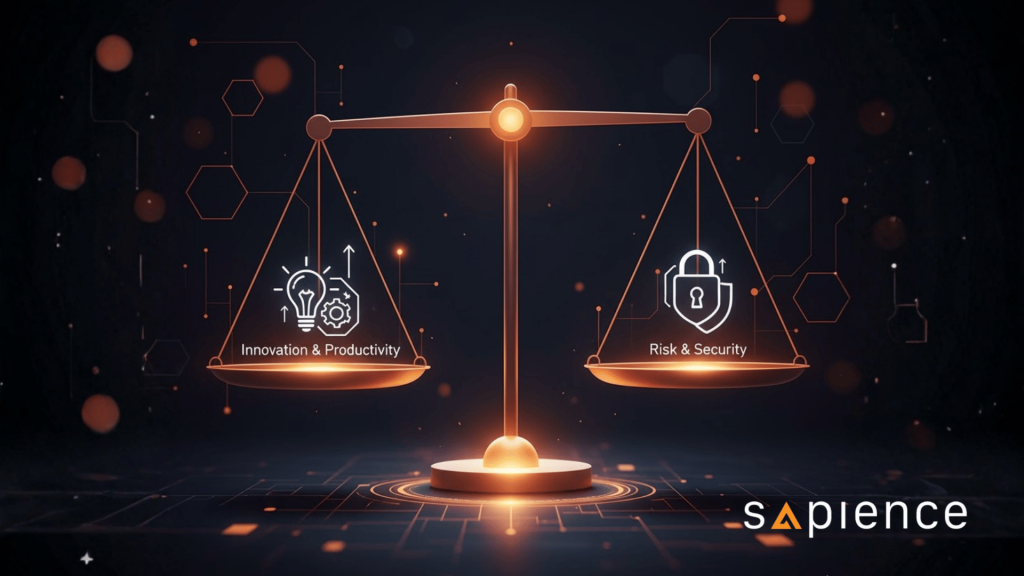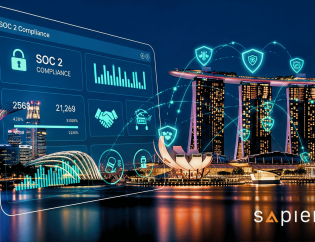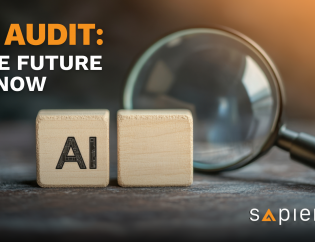Harnessing the Power and Managing the Risks of Generative AI Tools
Written by:
Consultant
Sapience Consulting

In recent years, generative AI (GenAI) tools such as ChatGPT, Gemini, Copilot, and other emerging platforms have evolved from being technological curiosities to becoming critical tools for businesses. These tools can generate text, code, images, and even audio, offering new ways to improve productivity, innovation, and decision-making.
Organisations are using GenAI across multiple functions such as customer service, marketing, software development, and research. A GenAI assistant can help employees retrieve internal information, summarise lengthy documents, and automate repetitive tasks. Marketing teams can use it to create content drafts, while developers can accelerate coding and testing.
From a strategic viewpoint, early adopters of GenAI may gain a competitive edge by improving operational efficiency, speeding up product development, and enhancing customer engagement. Beyond productivity, however, GenAI represents a platform shift. It changes how knowledge is accessed, how work is performed, and how organisations innovate. But it also introduces new cybersecurity and governance challenges that cannot be ignored.
How These Tools Can Help Organisations
Knowledge Work and Internal Assistance
GenAI can act as an intelligent assistant that helps employees find relevant documents, extract insights, and summarise key points. This saves time, especially for new staff who need to learn internal systems quickly.Content Generation and Creativity
Marketing, communications, and design teams can use GenAI to generate blog drafts, social media posts, or creative concepts. Rather than starting from scratch, they can refine AI-generated drafts, improving speed and creativity.
Process Automation and Augmentation
Routine tasks such as email triage, meeting summaries, and report generation can be automated. GenAI can also serve as a first-level support agent, responding to simple queries and escalating complex ones to human staff.
Decision Support and Insight Generation
GenAI can analyse large amounts of unstructured data and generate insights from customer feedback, internal reports, or communication logs. It can help business leaders make data-driven decisions more effectively.
Cybersecurity and Operations Support
In cybersecurity, GenAI can assist with summarising threat intelligence, writing incident reports, or analysing log data. While it introduces risks, it also enhances defenders’ capabilities when used carefully.
When adopted thoughtfully,
GenAI enhances productivity, creativity, and decision-making across multiple domains.
Cybersecurity Flaws and Risks Associated with Generative AI
Despite the benefits, GenAI tools also introduce serious cybersecurity challenges. The same systems that generate insights and automation can also become sources of data leaks, compliance issues, or attack vectors if used carelessly.
Data Leakage and Privacy Exposure
Employees might unintentionally input confidential business information, intellectual property, or personal data into AI tools. If these prompts are stored or used for training, sensitive data could be exposed.
Model Manipulation and Prompt Injection
Attackers can attempt to manipulate the AI model through malicious prompts or data poisoning. Prompt-injection attacks, for example, can trick a model into revealing hidden data or performing actions outside its intended scope.
Phishing, Social Engineering, and Deepfakes
GenAI makes it easy to create convincing phishing messages, fake documents, or deepfake videos. This increases the volume and realism of scams, making them harder to detect.
Offensive Use by Adversaries
Malicious actors can use GenAI to write malware, generate phishing campaigns, or identify vulnerabilities faster than before. The same innovation that empowers defenders also helps attackers.
Governance and Compliance Risks
Without proper oversight, GenAI use can lead to intellectual property violations, data protection breaches, or non-compliance with privacy regulations. Shadow AI—where employees use unapproved AI tools—can also undermine governance.
Operational and Supply-Chain Risks
Integrating GenAI into business systems can introduce dependencies on external vendors or third-party components, expanding the organisation’s attack surface.
These risks demonstrate the importance of strong governance and technical controls when adopting GenAI.
Security Best Practices and Mitigation Strategies
To harness the benefits of GenAI while managing risk, organisations should adopt a structured and proactive approach that includes governance, technical controls, and user education.
🗒️Establish Clear Governance and Policies
Create an AI governance board responsible for evaluating GenAI use cases, setting policies, and monitoring compliance. Define what data can be used, what tools are approved, and how activity is logged.
🎛️ Protect Data Through Classification and Access Controls
Classify data before feeding it into AI systems. Sensitive or regulated data should be excluded or anonymised. Use encryption for data in transit and at rest, and apply role-based access controls to limit exposure.
🔎 Assess and Manage Vendor Risks
When using third-party AI tools, review their data handling practices, security certifications, and data retention policies. Ensure that vendors do not use company data to train their models without explicit consent.
👁️ Monitor and Validate Model Behaviour
Continuously monitor GenAI systems for unusual activity or unexpected outputs. Keep audit trails of prompts and responses for high-risk use cases. Conduct red-team testing to simulate prompt-injection or model-poisoning attacks.
👥 Maintain Human Oversight
Always keep humans in the decision loop, especially in high-stakes areas such as cybersecurity, finance, or compliance. GenAI outputs should be reviewed and validated before implementation.
✍️ Train Employees and Build Awareness
Educate staff about the appropriate use of GenAI tools, data privacy obligations, and potential risks. Employees should know not to share sensitive data and how to identify suspicious or misleading outputs.
🔒 Implement Secure Deployment and Network Controls
Deploy GenAI systems in secure environments with sandboxing, data-loss prevention tools, and encryption. Isolate experimental systems from production networks until tested and approved.
📋 Ensure Compliance, Transparency, and Fairness
Regularly audit AI outputs for bias or inaccuracies. Maintain transparency about AI use, especially in customer-facing systems. Ensure compliance with data protection and intellectual property laws.
📢 Update Incident Response Plans
Extend existing incident response and business continuity plans to include AI-specific risks such as model compromise, data leakage, or deepfake exploitation. Include clear steps for isolation and rollback.
🔁 Review and Improve Continuously
The AI landscape evolves rapidly. Periodically reassess risk exposure, update security controls, and refine policies based on new threats or regulatory changes.
Next-generation generative AI tools offer organisations powerful opportunities to enhance productivity, innovation, and decision-making. However, they also introduce new risks related to data privacy, cybersecurity, and governance.
The key to safe adoption lies in balance: embracing innovation while maintaining strong oversight. Organisations should treat GenAI tools as critical infrastructure, with the same level of security, monitoring, and compliance as any major IT system.
By combining robust governance, technical safeguards, and user education, businesses can harness the advantages of generative AI without sacrificing security or trust. Those that act strategically will not only stay ahead of competitors but will also build resilient, responsible AI-enabled organisations prepared for the challenges of the future.
Check out our IBF and SSG funded courses! There is no better time to upskill than now!











